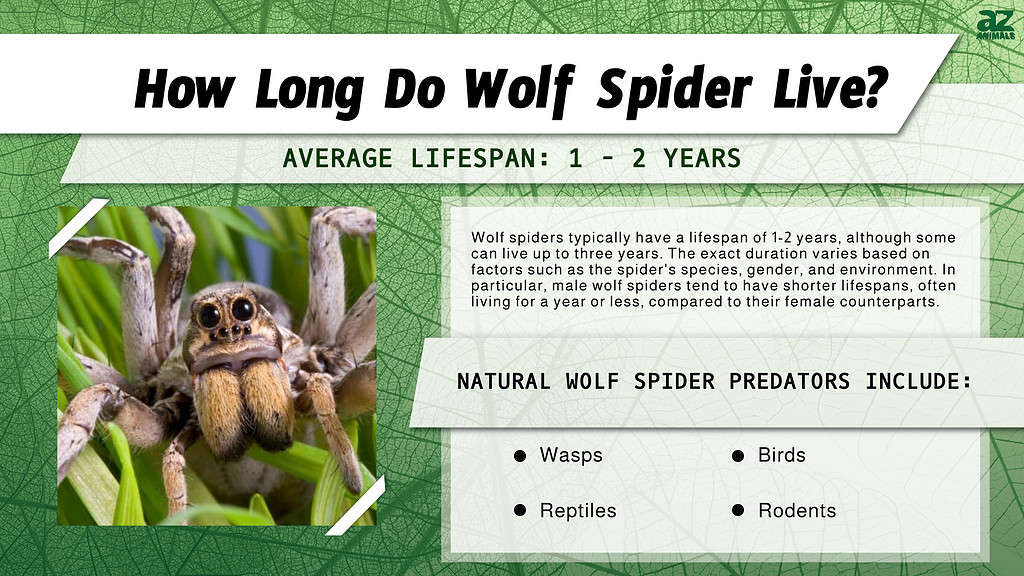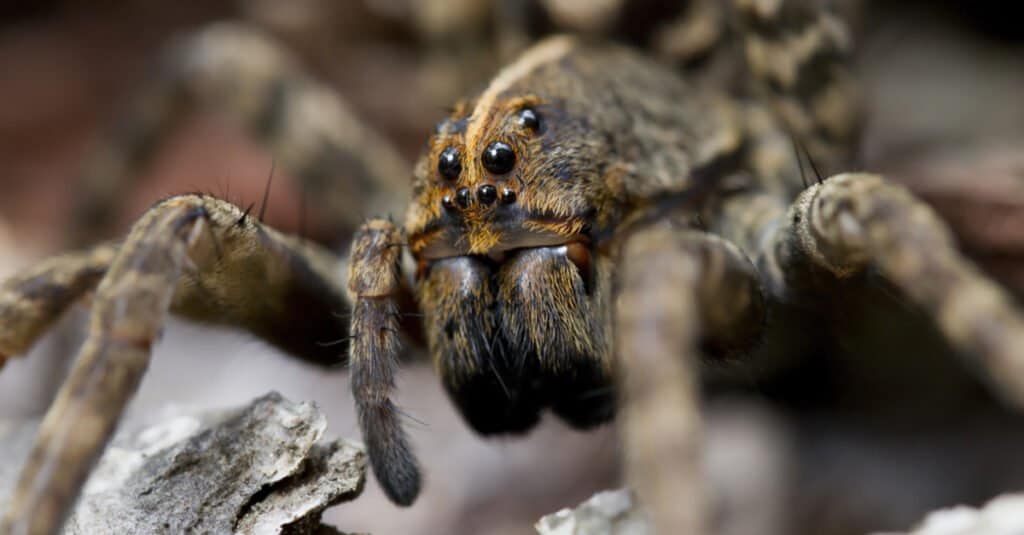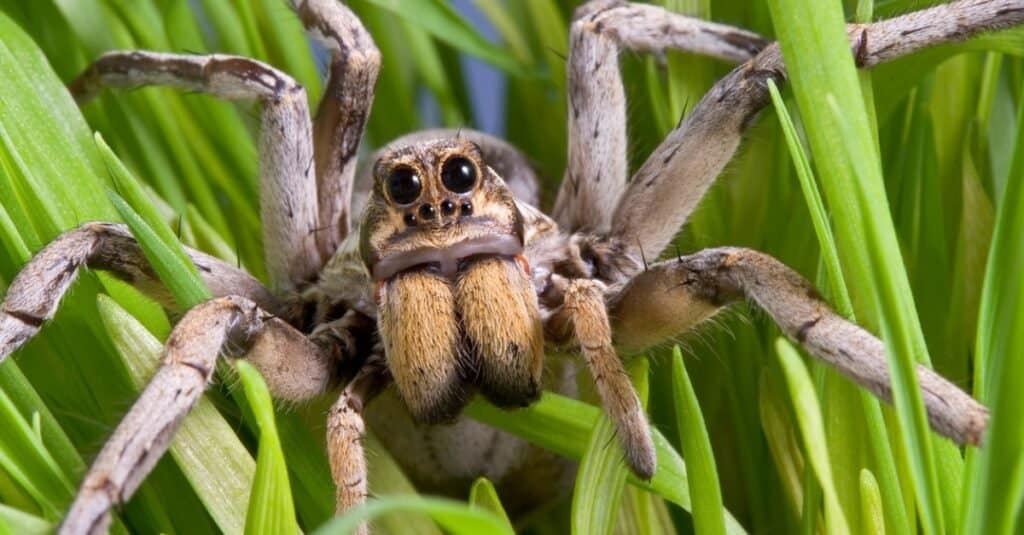
Wolf spiders can be creepy, crawly, and just downright scary. Besides being big and hairy, these arachnids stand out from other spiders that mainly use webs to capture prey. Instead of using webs, wolf spiders actively hunt and chase down their prey, as wolves do in the animal kingdom. But how long do these fierce predators live?
Well, you may be surprised to learn that wolf spiders can live up to three years! However, this varies depending on the environment, species, and gender. In this article, we’ll dive into the lifespan of wolf spiders and even take a closer look at their development and life cycle. Let’s get started!
How Long Do Wolf Spiders Live?

Wolf spiders generally live between 1-2 years.
©Will E. Davis/Shutterstock.com
Wolf spiders generally live between 1-2 years, but they can live up to three years. This varies considerably depending on the spider’s species, gender, and environment. For instance, male wolf spiders have shorter life spans than females and often live for a year or less. Many of them die shortly after mating, but their small size makes them more susceptible to predators and environmental factors. On the other hand, females live a bit longer for several breeding seasons.
Depending on their environment, wolf spiders may live longer than you think. Their resilient nature allows them to adapt to their environment easily and survive longer. As mentioned earlier, they may live for about 1 to 18 months in the wild. However, this can be extended up to 3 years in captivity or when kept as pets. So, what exactly causes this drastic difference in lifespan?
In the wild, these crabby creatures face various threats, including predators, severe weather, and scarcity of food or resources. This constant struggle to survive can take a toll on their survival rate and shorten their lifespan. However, these threats are significantly minimized in captivity and when well cared for.
Despite the threats faced in the wild, wolf spiders have evolved to adapt and survive in their natural environment. They are highly agile hunters and have excellent camouflage abilities, making it difficult for predators to detect them. Furthermore, female wolf spiders provide maternal care for their offspring, increasing the likelihood of their survival.
The Average Wolf Spider Life Cycle

Female wolf spiders lay approximately 100 eggs at a time.
©iStock.com/Henrik_L
Like most spiders, wolf spiders go through several stages of development before reaching adulthood. Let’s get to understand each stage a little better:
Egg and Egg Sac
For starters, wolf spiders are selective when choosing a mate. Males will perform courtship displays and may even fight off other male competitors. Once the female accepts the male’s advances (mating), she goes into isolation in a covered location where she will lay her eggs.
Females lay approximately 100 eggs at a time, which are then wrapped up in a silken egg sac for protection. The females guard the egg sac attached to their spinnerets and often keep it until the spiderlings hatch. If the egg sac is disturbed or removed during incubation, the female furiously searches for it and reattaches it if found. The incubation period for wolf spider eggs lasts about 2-3 weeks before the spiderlings hatch.
Spiderlings or Young Spiders
When the eggs are ready to hatch, the mother spider uses her mouthparts to rip open the egg sac and release her spiderlings. These young spiders are miniatures of the adult but still have some growing to do before reaching maturity. In fact, the young wolf spiders will molt several times before reaching maturity. The spiderlings often stay close to their mother during this stage for protection. They may even hitch a ride on her back while she hunts for food. As they grow bigger and stronger, they will venture out to hunt and find a place to build their webs.
Adult
After several molts (shedding their exoskeleton as they grow), the wolf spider is fully developed and ready to hunt and reproduce. The average lifespan of a wolf spider is about one to two years.
What Factors Affect The Wolf Spider Lifespan?

Wolf spiders are known for their hunting prowess and solitary nature.
©iStock.com/CathyKeifer
Wolf spiders are known for their hunting prowess and solitary nature. But like all living creatures, some factors can shorten their lifespan. Here are a few examples:
Predation
As they are at the top of their food chain in their habitats, wolf spiders can fall prey to predators like wasps, praying mantises, Gordian worms, flies, lizards, snakes, mites, etc. Predators like praying mantises are known to be a threat to any spider. They snatch their victims or ambush them quickly before they can react and defend themselves. Also, some spiders can fall prey to their kind. For instance, a male wolf spider may try to mate with a female, but if she is not interested or ready, she can potentially eat him instead.
Human Interference
If the natural habitat of a wolf spider is disturbed or disrupted, it can shorten its lifespan. This can be through deforestation, pollution, or excessive development. Not only do these actions restrict the food available to wolf spiders, but they also expose them to their predators. Using pesticides in the immediate environment may also harm wolf spiders, leading to a shorter lifespan. This can also indirectly affect wolf spiders by killing off their prey species.
Aside from habitat destruction, human interference also leads to an increase in wolf spider predators. Introducing non-native species, such as snakes, disrupts the balance of the ecosystem and gives wolf spiders more threats to their survival. Accidental or intentional injuries from human activity may also cut short a wolf spider’s lifespan.
Genetics and Health Conditions
Although spider genetics influence their lifespan, diseases and viruses are not so common. However, contracting a disease or suffering from a genetic defect can result in death. Mites and worms cause more common health problems encountered in these spiders. These external parasites can take a toll on their health and ultimately shorten their lifespan.
The photo featured at the top of this post is © Cornel Constantin/Shutterstock.com
Sources
- JSTOR, Available here: https://www.jstor.org/stable/3248
- Animal Corner, Available here: https://animalcorner.org/animals/wolf-spider/
- University of Kentucky, Available here: https://www.uky.edu/Ag/CritterFiles/casefile/spiders/wolf/wolf.htm
- , Available here: http://nswfmpa.org/Husbandry%20Manuals/Published%20Manuals/Invertebrata/Wolf%20Spider.pdf
Thank you for reading! Have some feedback for us? Contact the AZ Animals editorial team.






